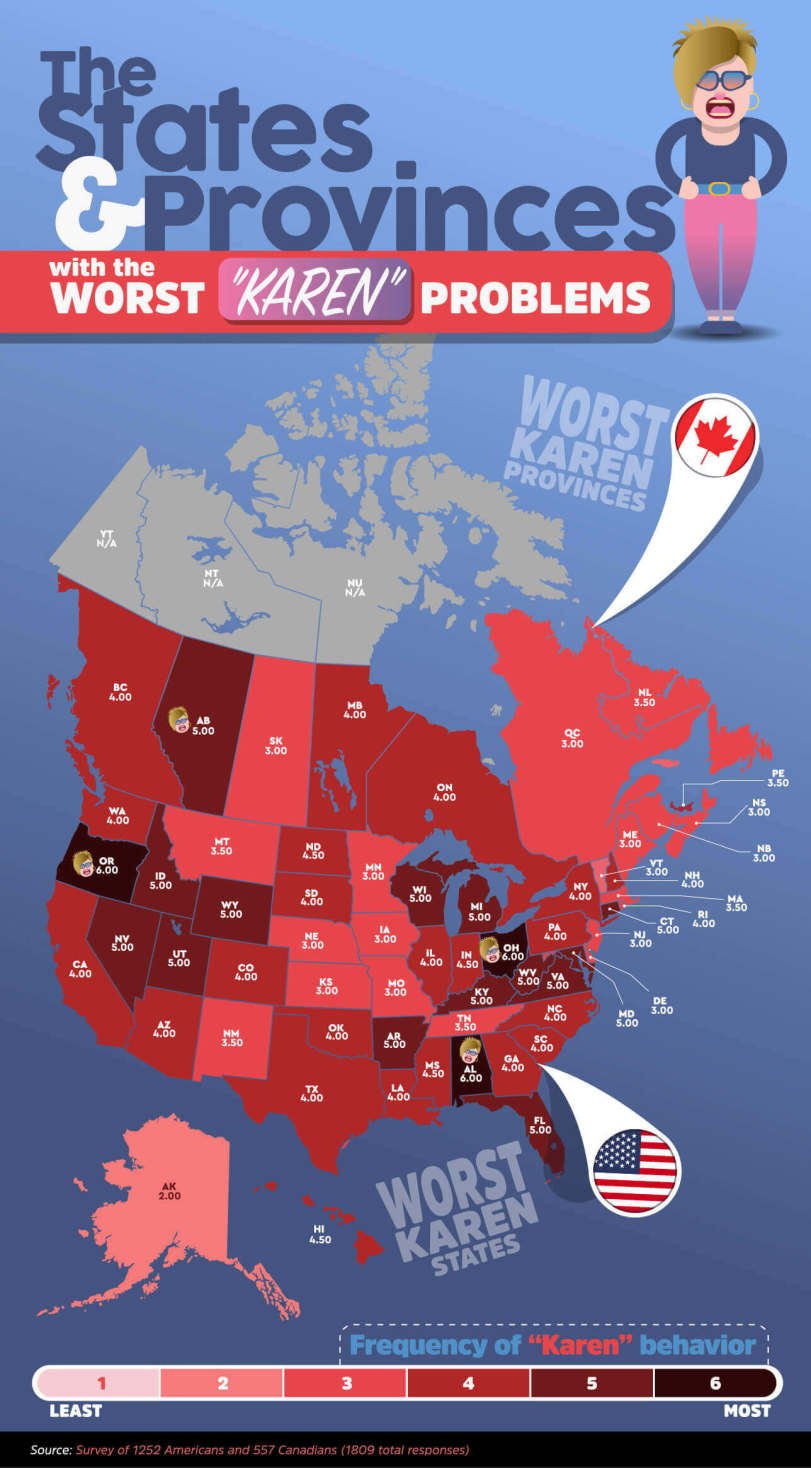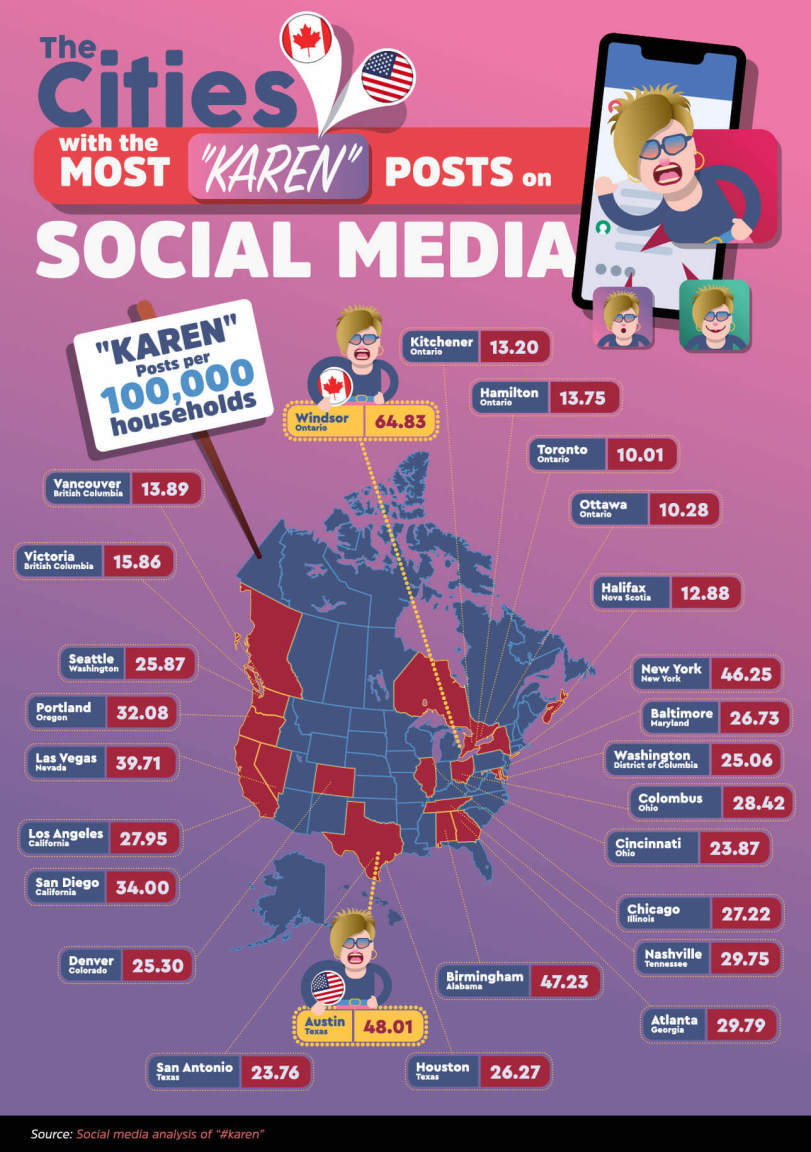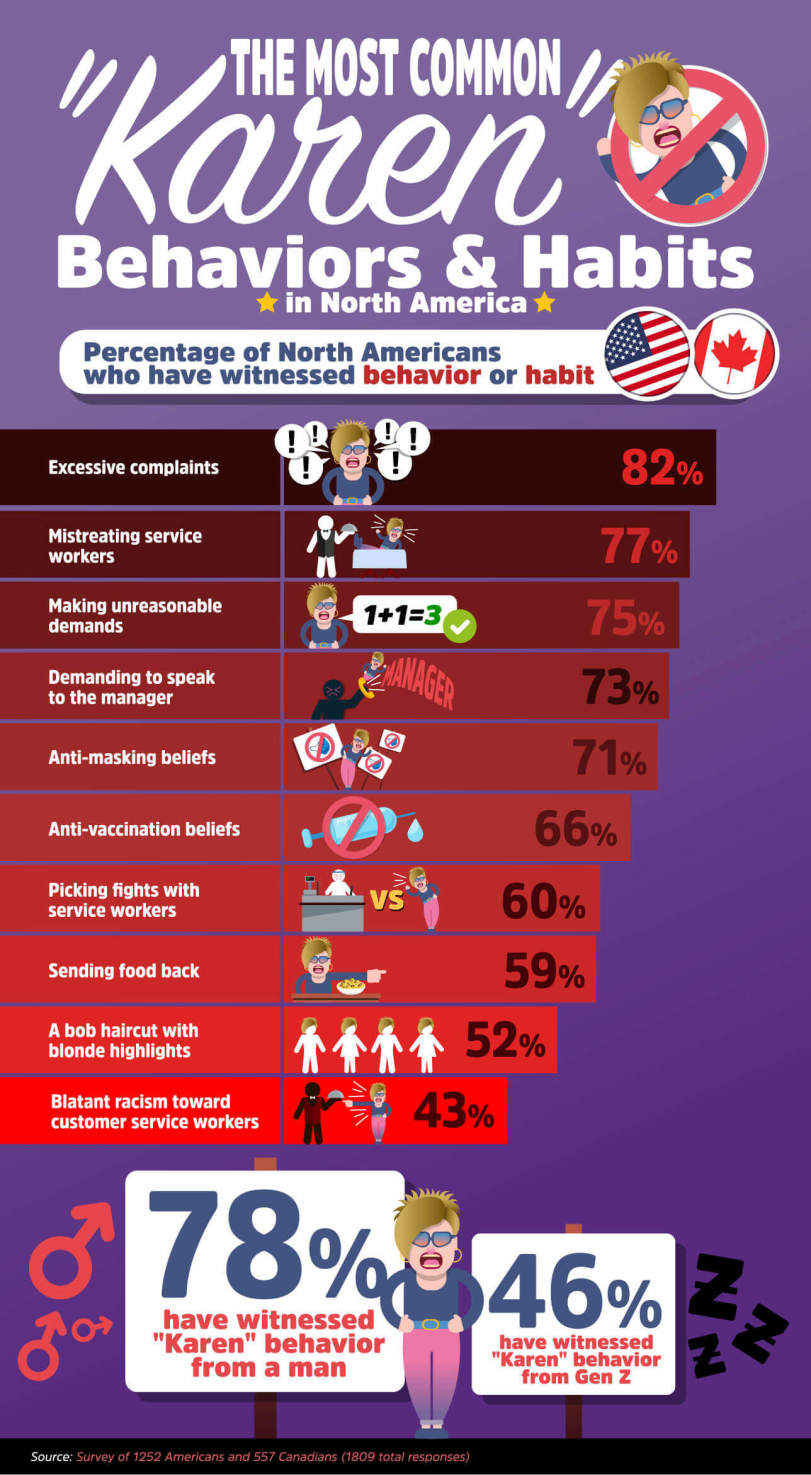Karen Capitals: The States and Provinces With the Worst “Karen” Problems
Published 14.04.2023
You’re sitting in your favorite fast food joint enjoying the grandeur of a $2 meal when suddenly, you see them. Middle-aged, usually a female, probably white, very often with a blonde bob haircut, and donning that unmistakable look of entitlement that can only mean one thing: your peaceful burger-and-fries afternoon is about to be ruined by a “Karen.”
We’ve all seen them, but some of us have the displeasure of running into Karens more often than others. We conducted a survey of over 1,800 people in the U.S. and Canada to see where the Karens of the world disrupt the peace the most often. We also gathered some data on the worst Karen behaviors and whether the Karen persona crosses generations and genders.
The States and Provinces With the Most Karens
First, we wanted to know where people run into Karens the most often. We asked our survey participants how often they see Karens out in the wild, on a scale from 1 to 10.

In the United States, Alabama, Ohio, and Oregon are the states with the highest Karen density, all achieving a score of 6.0 out of 10. There were 13 states following closely behind that scored a 5.0 out of 10, including Arkansas, Connecticut, Florida, Idaho, Kentucky, Maryland, Michigan, Nevada, Utah, Virginia, West Virginia, Wisconsin, and Wyoming.
Canadians experience Karen behavior a bit less often. Alberta came in as the top province for Karen density and is the only province to score a 5.0. New Brunswick, Nova Scotia, Quebec, and Saskatchewan all scored a 3.0, the lowest of any province in the country.
If you’re looking to avoid Karen behavior as much as possible in the U.S. — and let’s be honest, who isn't? — you should head to Alaska. The Last Frontier scored a 2.0, the lowest of any state/province we surveyed. Along with the lower Karen density in Canada than in the U.S., this suggests that Karens may not like the cold. Vermont, Maine, New Hampshire, Montana, and several other colder states in the nation scored below average.
If you live in Canada and want to steer clear of Karen encounters, you’ll be best off in New Brunswick, Nova Scotia, Quebec, or Saskatchewan, all of which scored the lowest in the country.
The Cities With the Most “Karen” Posts on Social Media
Seeing a Karen in real life isn’t something any of us want to experience. Seeing them or hearing about them on social media is a little more tolerable, especially if they get owned immediately after their outburst. Next, we wanted to see which cities produce the most Karen posts on social media platforms.

In the U.S., Austin, Texas, is the hotspot for reported Karen activity. There were an impressive 48.01 Karen hashtags produced for every 100,000 households in the city, putting Austin at #1 in the country. Only two other cities — Birmingham, Alabama, with a 47.23, and New York City, New York, with a 46.25 — generated over 40 Karen posts per 100,000 households.
Windsor, Canada, tops the charts with a staggering lead, though. An incredible 64.83 Karen reports were posted on social media in the city per 100,000 households. Windsor is one of the southernmost Canadian cities…so our theory that Karens can’t handle the cold holds up!
The next highest number of Karen posts from a city in Canada was Victoria in British Columbia, with just 15.86 per 100,000 households. No other city in the country scored above 14.
The Worst “Karen” Behaviors and Habits in the U.S. and Canada
We know Karens can exhibit some truly abominable behavior, but we wanted to know what the most common behaviors and habits were among the Karen population. We asked our 1,800+ survey participants what the worst Karen behaviors they’ve noticed were.

The top Karen habit, with a sizable lead, was inordinate complaining. A disconcerting 82% of respondents confirmed that they had, at some point, witnessed a Karen complaining needlessly and excessively.
Four other Karen behaviors were experienced by more than 70% of participants:
-
Mistreating service workers (77%)
-
Making unreasonable demands (75%)
-
Demanding to speak to a manager (73%)
-
Anti-masking beliefs (71%)
Thankfully, the least common Karen behavior to be seen in the U.S. and Canada was blatant racism toward customer service workers. However, this behavior still reared its head far too often, with 43% of surveyees reporting that they had witnessed it.
Karen Behaviors Span Generations and Sexes
While Karen tendencies are usually associated with middle-aged, entitled white women, younger people and men aren’t exempt from the occasional Karen habits. A surprising 78% of survey participants reported that they had seen Karen behavior come from a male, and 46% witnessed Karen tendencies in Gen-Zers.
Wrapping Up: How to Avoid Karens In Your Everyday Life
As entertaining as it is to watch Karens getting what they deserve on social media, no one wants to encounter one in real life. If you do see a Karen, get your phone out and document like there’s no tomorrow. Only 2% of surveyees reported that they had filmed a Karen in the past. Karens will always be present; you might as well get some lasting entertainment out of your Karen experience!
Methodology
We surveyed 1,252 Americans and 557 Canadians — a total of 1,809 participants — between April 4th and April 5th.
Fair Use
Feel free to share this research with anyone you like. If you publish or refer to this content on your website, please include a link to this page.
